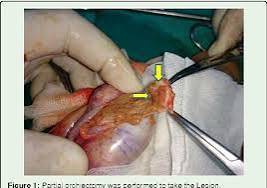Testicular Tuberculosisq
Testicular tuberculosis (TB) is a rare form of extrapulmonary tuberculosis caused by Mycobacterium tuberculosis. It typically spreads from the lungs or other primary sites through the bloodstream or lymphatic system to the genitourinary tract, including the testicles and epididymis.
---
Causes
1. Primary Infection:
Caused by Mycobacterium tuberculosis, usually originating from pulmonary TB.
2. Hematogenous Spread:
Bacteria travel from the lungs or other TB-infected sites to the testicles via the blood.
3. Direct Spread:
From nearby organs such as the prostate, bladder, or kidneys.
Risk factors include:
Active or past tuberculosis infection.
Immunocompromised states (e.g., HIV/AIDS).
Diabetes mellitus.
Poor living conditions or malnutrition.
Close contact with individuals with TB.
---
Signs and Symptoms
Scrotal Swelling: Gradual enlargement, usually painless in the early stages.
Testicular Pain: May range from mild to severe as the disease progresses.
Epididymal Mass: Firm, irregular lump felt in the epididymis or testicle.
Fever and Night Sweats: Common systemic TB symptoms.
Weight Loss: Associated with chronic infections like TB.
Scrotal Sinus or Ulcer: Advanced cases may develop draining sinuses or skin lesions.
Urinary Symptoms: Dysuria (painful urination) or hematuria (blood in urine) if the urinary tract is involved.
---
Effects
1. Infertility:
Damage to the testicular tissue and obstruction of the reproductive tract can impair fertility.
2. Chronic Pain:
Persistent pain due to tissue damage or inflammation.
3. Abscess Formation:
Localized pus accumulation may occur if left untreated.
4. Scrotal Deformity:
Advanced infection can lead to tissue destruction and disfigurement.
5. Systemic Spread:
Untreated TB can disseminate to other organs, causing life-threatening complications.
---
Solutions
1. Diagnosis:
Medical History and Physical Exam: Evaluation of symptoms and TB risk factors.
Ultrasound: Imaging to detect abnormalities in the testicle and epididymis.
TB Testing:F
Tuberculin skin test (Mantoux test) or interferon-gamma release assays (IGRAs).
Microscopy and Culture: Testing for Mycobacterium tuberculosis in urine or scrotal discharge.
Biopsy: Definitive diagnosis by examining testicular or epididymal tissue.
2. Treatment:
Antitubercular Therapy (ATT):
A combination of first-line drugs, such as isoniazid, rifampin, pyrazinamide, and ethambutol, is administered for 6-9 months.
Surgical Intervention:
Required in severe cases for draining abscesses or removing necrotic tissue.
Orchiectomy (removal of the affected testicle) may be necessary in advanced disease.
3. Supportive Care:
Nutritional support to improve immunity and recovery.
Pain management with analgesics.
4. Prevention:
Early Detection and Treatment of Pulmonary TB: Reduces the risk of dissemination.
Vaccination: Bacillus Calmette-Guérin (BCG) vaccine helps prevent severe TB forms.
Screening: Regular health check-ups for individuals at high risk of TB.
Improve Living Conditions: Address overcrowding and poor sanitation.
5. Management of Underlying Conditions:
Control diabetes or other immune-compromising conditions to reduce susceptibility.
---
Prognosis
With timely diagnosis and proper antitubercular treatment, testicular tuberculosis is curable. However, delays in treatment can lead to permanent testicular damage, infertility, and life-threatening systemic complications. Early medical intervention is crucial for a favorable outcome.


